Humbled by Ruffed Grouse in Michigan’s Upper Peninsula

“Much of the pleasure of shooting is what accompanies it and sharing it all with a good friend.” ~ George Bird Evans, The Upland Shooting Life (1971)
The child tells what he got for Christmas, the mature man tells how he spent the day; the immature hunter tells how many birds he shot, the mature gunner tells of the experience. If I can impart a sense of gunning values through my writing, I urge the gunner at any age to lift himself above the childish state of mind, thinking only of himself and not what he is doing to the birds.
– George Bird Evans, An Affair with Grouse (1982)
Of course George Bird Evans is absolutely right. It’s the experience and comradery not raw, feathered body count that makes for a memorable hunt. But on the other hand, it’s always better when you come home with a bagful of birds…right?
From the very outset every upland quest is a ticket to the Promised Land. As kids we ogled those illustrated shotgun shell boxes from Winchester and Peters of plump birds flushing from field and marsh. Then we grew up and bought wildlife art with glorious covey flushes, hunter’s side by side poised for the shot, his feet in perfect position, dog eager to retrieve. Bang, bird down.

Tracey Lieske
When you’re driving 20 hours to the fabled ruffed grouse paradise of the Michigan Upper Peninsula, on a hunt guided by the great Tracey Lieske, in a way you’re expecting to enter one of those paintings. Why suppose otherwise? It was certainly the life lived by Tracey, so he had the know-how to share it.
As a kid in Michigan he spent his boyhood hunting grouse and woodcock and voraciously reading the books of the upland greats including Gene Hill, Burton Spiller and later on Steve Smith. He had graduated in 1985 from the University of Michigan with a Bachelor’s Degree in Environmental Science. He’s been training gun dogs since age 12 and guiding upland hunters for more than a quarter century. He plied his trades at top-notch hunting venues including Greystone Castle, Deer Creek Lodge, Flying B Ranch, Quail Creek and Paul Nelson Farm.
At the Wild Wing Lodge and Kennel in Western Kentucky he had an opportunity to purchase the 12,000-acre operation in 2010. After seven years as owner and operator he realized that he was spending more time behind the desk than out in the field. So he sold the place.
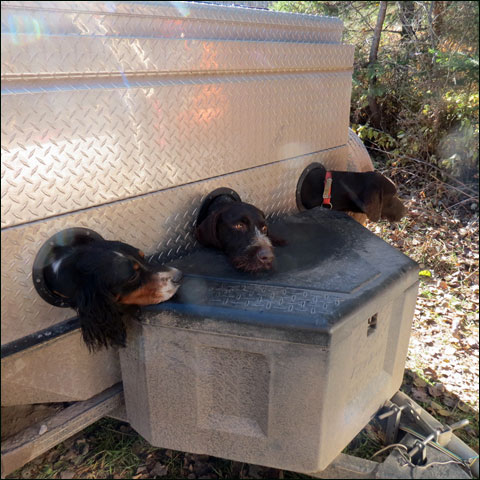
Tracey Lieske’s dogs eager to get out and hunt.
He started Wild Wing North Outfitters in 2015. He had been bringing Wild Wings dogs north for training and conditioning. Some customers heard he was doing that and he started bringing guests up to work dogs and they wanted to hunt and he started to look for places to stay.
“We’re sort of a vagabond group where we find birds during summer training sessions,” he said. During those training expeditions he locates birds and lodging. “I started at Paint River this year. In years prior he went to the Gateway Lodge in Land Ó Lakes, Wisconsin.”
Despite the vagaries of hunting, one thing was for certain: Tracey is considered a guru. Magazine articles and the Internet have sung his praises, so I knew our hunt would be great.
On day two driving from my hometown of Thomasville, Georgia, I had arrived in Crystal Falls, Michigan at the Paint River Landing motel, at about 4:00 PM on October 21stof 2018. Paint River Landing, like the town of Crystal Falls, is a throwback to mackinaw coats and rabbit-lined hats with ear flaps.

In the early 1880s Crystal Falls was a major iron ore mining town. Now tales persist of mines haunted by the spirits of those who died in cave-ins and floods. The Crystal Falls Iron County court house is a brick 1911 showcase of Romanesque excess with a turret, belfry and clock tower – a hilltop monument to the logging heyday when cut trees were ferried along seven rivers that intersected the region.
Crystal Falls’ summer attractions include swimming, fishing, canoeing, mountain biking and hiking. Winter activities feature skiing, snowmobiling, snow shoeing and ice fishing. I had arrived between the seasonal rushes. With a local population of about 1,500 the wintry forlorn atmosphere would probably linger until the first snow dump, which could accumulate into some five feet of snow per year – more than twice the national average.
One night I had asked one of the bartenders what she did during the winter in Crystal Falls. “We snowmobile and drink. We ice fish and drink. We watch football and drink. And sometimes we just drink.”

The row of guest cabins at Paint River Landing.
The Paint River Landing motel was one of those places that would look infinitely better covered in snow. With bare trees, the gravel parking lot gave a stark feel to the log bar and restaurant where I checked in, and the nine log cabins on the far side of it.
I entered the spacious knotty-pine interior, the long bar back-lit by beer coolers. The place felt like an Elks social hall. To the right was a stage and dance floor. A few tables populated the bar area while the main dining room was off to the left. Several men watched sports from the bar stools. I approached the bartender who was a lovely long-legged brunette with a warm smile and snug sweater. Her name was Laura Urban. She told me which of the nine riverfront log cabins I’d be in, then said that Tracey was on a hunt and would show up later.
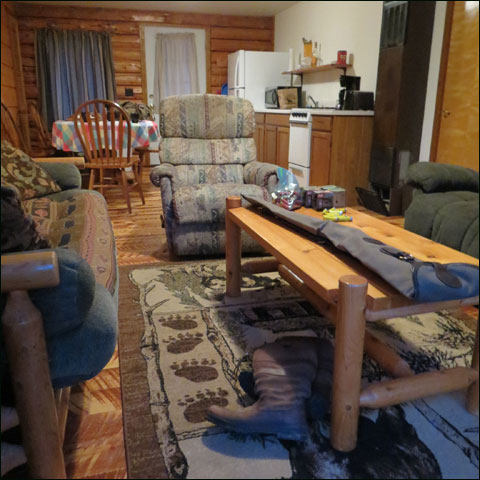
Step inside cabin three.
Cabin three was amongst a trio of single-story buildings comprised of adjoining cabins. A dusting of frost covered the peaked roofs. You entered a handyman’s cabin kitchen, with a small table covered in plaid vinyl. Further in was a sad couch and recliner. Two compact bedrooms each had two single beds not much bigger than a cot. The bathroom appeared lifted from a 1960s single-wide trailer, and I noticed there was no soap. Through sliding glass doors a small balcony fronted the Paint River. The cabin was like a North Woods grouse camp (that took credit cards). I claimed one of the bedrooms and, ready for a beer or two, returned to the bar.
A scruffy guy in his fifties, his eyes dilated with madness, sat two stools away. He struck up a conversation. I asked him what he did during the day around here and said he drank in bars. He kept circling back to an offense he recently suffered after getting thrown out of a bar for repeatedly complaining about the pizza.
Before long, a guy I would say in his early sixties took a stool on the other side of me. He looked sane, cheery and trim. Our conversation quickly revealed we were cabin mates on Tracey’s hunt. His name was Doug Whitley. A retired lobbyist, he lived a few hours away in Michigan. I complimented his shirt and he said he bought it at Kevin’s in Thomasville, Georgia – my hometown. Small world. He was a dedicated wingshooter who traveled throughout the U.S. hunting. Over beers we talked about the sporting life.

Doug Whitley during our hunt.
Tracey soon joined us at the bar. A contemporary of ours he was thin, with his trademark moustache, and seemed quite unassuming and friendly. We grabbed a bar table for dinner and beers. Afterwards, Doug and I returned to the cabin, and I knew I had hit the jackpot when he placed a fifth of Glenmorangie Original Single Malt on the shelf over the sink.
With temperatures dropping we tried to start the wall heater. Nothing. Owner B.J. Havlik came to ignite the pilot light. I told him there was no soap in the bathroom. “We don’t supply soap,” he said. As it turned out, I usually pack bars of soap on hunting trips and brought extra that I could give Doug.
The first morning of the hunt began with a lavish breakfast in the restaurant, cooked and served by Katy Havlik. She also gave us delicious pastries for the road. I had forgotten to get a hunting license. We drove into downtown Crystal Falls where the grocery-liquor-hardware store sold them. There were lots of guys in there wearing camo and blaze.
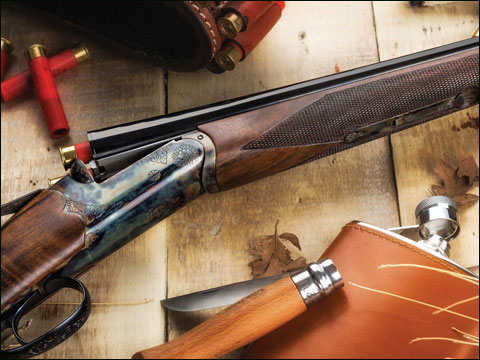
A Dickinson Estate roundbody like the one used by the author on the hunt.
Our road-warrior rig was Tracey’s older Chevy Suburban pulling a dog trailer. The Suburban’s cargo area held our gear and two kennels with dogs. I had packed a couple of shotguns: a lovely Dickinson Estate roundbody side by side that was a .410/28-gauge combo (I only brought the 28-gauge barrels) and a 20-gauge Beretta A400 Xplor semi-auto.
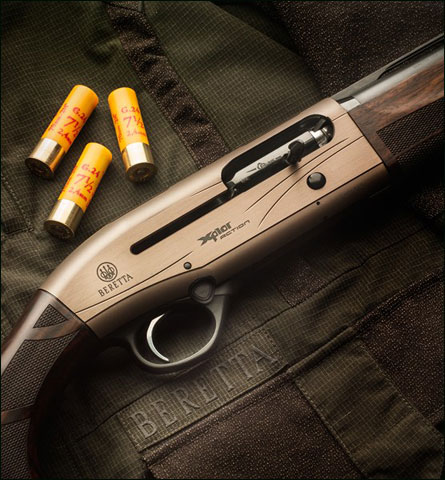
The Beretta A400 Xplor semi-auto in 20 gauge.
We drove about 40 minutes, half of that time on slow-going logging roads. Since Doug read maps much better than me, he sat up front to help navigate.
We would hunt the Michigan Department of Natural Resources’ popular Grouse Enhanced Management Sites (GEMS). The GEMS program started in 2014 to boost the local economy with “must-hunt” locations. The program made a lot of sense, since Michigan has more public land than any other state east of the Mississippi. And Michigan is always a top Midwest destination for ruffed grouse and woodcock.
With GEMS, the Michigan DNR started intensively managing sites to provide unique, walk-in hunting opportunities for ruffed grouse and woodcock. These hunting habitats are partially funded and maintained with the Ruffed Grouse Society and American Woodcock Society, along with partnerships supported by local businesses.

Tracey Lieske (left) and Doug Whitley watching the dogs.
Habitat management for food and cover is highly cultivated on the GEMS trails. A closely monitored timber harvest schedule helps to provide ideal wildlife habitat. Many of the old logging roads are converted to easily accessible walking trails with minimum terrain challenges. The Upper Peninsula has 10 GEMS trails of the state’s total 19. At first glance, these trails look easy to walk, but the heavy-machinery ruts under the cover can be real ankle-twisters.
Tracey had walked the GEMS trails during his summer bird-dog training sessions, making mental notes along the way where we could find the best hunting opportunities for ruffed grouse and woodcock. But as it turned out we wouldn’t bag a single bird in three days of hunting.

Tracey Lieske’s hunting rig.
Day one would play out over the three-day hunt. The early chill warmed to a sunny mid-60s. Tracey’s Drahthaars, English Setters and beloved English Field Cocker would range far – their dog bells a melody through the late-autumn forests of firs, aspens, birch, cedars, maples clover, rye grass, witch hazel and rose hips. The ground was thick with the seasonal palate of fallen leaves and the heartiest greens. Tracy kept an eye on the dogs circling and zig-zagging on the trail and into the dense trees on both sides. If a bell went quiet, or he saw a dog point, we often hustled off the trail and into woods.
The first morning, right out of the truck, we raised six grouse within 30 minutes, although no shots were taken since the birds escaped in low heavy cover before I could shoulder the gun. After about two-and-a-half hours of walking, Doug began picking up errant Bud Light cans. We decided to relocate. On our second GEMS trail I busted a single bird with no shots taken. Tracey imparted sage advice: take 10 steps then stop and listen. If a bird thinks you’re walking past, it will hold; but if it believes that you’re upon it, seen it, the chances of a flush get higher.
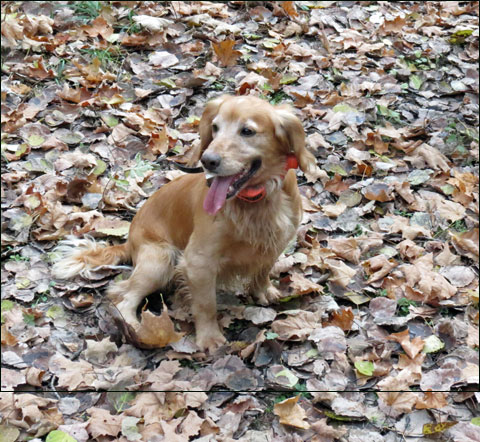
Cooper the mighty English Cocker.
We broke for lunch – driving about 20 minutes to the Hunters Bar in Ralph, Michigan. An olive-colored barracks-like building identified by a Coca Cola sign with the restaurant’s name, it sat on the crossroads of Turner Road and County Road 581. Cash only. The dirt parking lot was empty.
Tracey told us the place was a third-generation, mother-and-son operation. When we entered, the woman greeted Tracey as she passed carrying a basket of laundry. A short bar stocked with the basics, austere furniture, alcove of retail groceries and stark white walls fitted the name you expect from a Northwoods outpost in business since the early 1970s. The son, Ben, who looked mid-thirties, also knew Tracey by name. He gave us menus hand written on a sheet of white paper.
Hamburger garnishes included bacon, lettuce and tomato so Doug asked Ben for a BLT on toast. The son said he couldn’t do it. Doug countered that the menu showed bacon, lettuce and tomato. The son said they were only for hamburgers and after the both of them going round and round, the son flatly refusing to fix a BLT, Doug relented and ordered the house specialty called chili.
I subsequently saw this post on the Hunter’s Bar Facebook page:
“AGAIN ANOTHER THIEF IN MY BUSINESS. If you would have taken a shot glass, salt or pepper shakers it would still upset me, but to come in my business in the last week and pry open a picture frame and steal a Hunters Bar patch that is over 40 years old is pretty low. That patch was given to this business to let all the people see a part of history in this business. With muzzleloading season we have had lots of people daily in here, whoever took the patch please return it. No questions asked. It can be sent to the Hunters Bar Ralph Mi 49877.”
After lunch we drove roughly an hour to a different GEMS site. We might have found a closer one, but if Tracey saw a truck parked at the trailhead he continued down the road until he found the next empty gate.

Tracey Lieske scouring the woods for birds.
We capped off the entire day with nine low flushes, three points, a few birds busting and only a couple of shots fired. Nothing in the bag. With the light getting low, we packed it in for the day. Our 90-minute drive back to Paint River Landing took us through downtown Crystal Falls. He suggested dinner at the Infield Bar and Pizzeria in a small, corner industrial building with the glass-block windows we’ve come to associate with Second World War era factories.
Inside, AC/DC hit you hard through massive speakers. There was the long bar, pool table and regulars in their Upper Peninsula “tuxedos” of camo and blaze. The petite, dark-haired bartender resplendent in heavy cosmetics displayed an abundance of bosom with her low-cut top and push-up bra. At the pool table a skinny guy wearing a knit beanie played with a knock-out blonde who looked straight from L.A. We got doubly lucky because it was Mexican night and happy hour. I guess the burritos and nachos, prepared by the two women gringos who owned the joint, would be considered Mexican somewhere. Anyway, the food was really just an excuse to drink cheap beer.
Come the second day, Tracey told us he was up at 4:30 pouring over the GEMS trails map trying to figure out where he birds could be. He explained that earlier in the season he only needed to drive some 10 miles to find grouse and woodcock. Now in late October we were driving 40-50 miles just to get started.

Katy Havlik would send us off after breakfast with homemade pastries (here’s a raspberry pie pocket).
On the second morning he drove 60 minutes to his GEMS trail of choice. We moved only one bird during the first hour of hunting. We returned to the rig to change dogs and the subsequent hunt, which lasted approximately an hour, yielded nothing. By now, Tracey was pretty frustrated with his results. He explained that prior to our hunt the region experienced three weeks of rain that totaled about four inches – the latest downpours, three days before, accumulating slightly over an inch. Plus an inch of snow mixed with the rain during that time. His theory was that the ruffed grouse had either moved to their winter spots or were simply staying in the trees, when not feeding, due to the weather.
We drove nearly an hour to another GEMs site where Doug found himself in position to take a big woodcock, a strong-flying migratory female, flushed by one of the dogs. It was at least 40 yards out and getting away fast. His 20 gauge went for the Hail Mary shot and after unloading his two rounds that beautiful bird kept on going.
Shortly after I got a point deep into the trees. Getting there as fast as possible – twisting, bending, stepping over branches – I followed the dog until the running bird simply vanished.
In retrospect, I realized that our reactions had slowed by the lack of birds and the enjoyment of our own company. The conversations took up the slack and seemed to upend our priorities from hunting to story sharing. The afternoon sun also conspired to lull us into that pleasant camaraderie. And it occurred to me that I felt completely relaxed – walking on a warm autumn afternoon, shotgun over my shoulder, enjoying the dogs, with fellow hunters who proved to be excellent company.
On our third and final morning, I came out of the cabin to see Tracey talking with our neighbors, who said that he hadn’t seen any birds in days but did manage to shoot a few saplings. After our gourmet breakfast we drove 90 minutes to Tracey’s GEMS trail of choice. Walking 40 minutes, we flushed two ruffed grouse – no shots fired.
We ran into a lone hunter, no dog, who said he was from East Tennessee. He started out a week before us and had not fired a single shot. “I saw a few birds about 25-30 yards off but they were too quick for me,” he said. “Those chickens just took off.”
We decided to find another GEMS trail.

One of the gates at a GEMS trailhead.
It was later in the afternoon. Tracey’s rig plodded along the trail, when we came around a bend to see a old Chevy pickup blocking the way. We saw the driver slide from behind the wheel to the open passenger door. His shotgun slid through the open window. A shot fired. We figured he was a roadside hunter going for the grouse that he scared into a tree. The man got out of the truck and his legs weren’t moving right. He hobbled into the woods. After a few minutes Tracey was ready to volunteer one of his dogs, but the hunter managed his way out holding a single bird. He scored dinner.
Come our last hunt of the trip we were walking into the autumnal setting sun. One bird flushed and we couldn’t get a shot. We said that’s it and trekked back to the truck – returning to the trailhead.
As Tracey buttoned up a few things I remembered what he said earlier in our hunt: “Ruffed grouse hunting is one of the last pure things. The birds don’t survive in captivity and can’t be planted in fields.”
I walked away to pee against a tree. There was only sacred tranquility.
Irwin Greenstein is the publisher of Shotgun Life. You can reach him at contact@shotgunlife.com.
Useful resources:
The web site for Tracey Lieske’s Wild Wings North Outfitters and Pro Gun Dog Training

Irwin Greenstein is Publisher of Shotgun Life. Please send your comments to letters@shotgunlife.com.


Comments